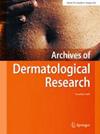Microbial evaluation of Melaleuca alternifolia essential oil for its antifungal activity against Trichophyton violaceum and its synergistic effects with ITZ and KTZ
Abstract
This study was designed to evaluate the effects of Melaleuca alternifolia essential oil for its antifungal activity as mono-therapeutic agent, and in combination with current antifungal agents, like itraconazole and ketoconazole. To assess the significance of TTO (Tea Tree Oil), ITZ (Itraconazole) and KTZ (Ketoconazole), for in vitro susceptibility pattern of dermatophyte, which was obtained from the cases of clinically examined dermatophytosis, attending the dermatology outpatient department of Sheikh Zayed Hospital. The tea tree essential oil was extracted through steam distillation method using 500 g of fresh Melaleuca alternifolia leaves from Lawrence Garden and obtained the yield of 3 mL that comes to be 0.6%. Trichophyton violaceum grown on SDA Sabouraud dextrose agar ager plates for 48 h were tested for fungicidal activity using equal quantity of TTO employing well method technique. In a comparative study assessing the minimum fungicidal concentration (MFC) of ITZ and KTZ, the MFC of KTZ was found to be greater than the MFC of ITZ because the solution of same concentration produced lesser inhibition zones in case of ITZ as compared to KTZ. In another study to ascertain the synergistic effects of TTO with ITZ, it was established that TTO significantly potentiated the effect of azoles in combination therapy reducing the MFC of ITZ up to 8 folds from 4 to 0.07 ug/mL. In yet another study to cross check the synergistic effects of TTO with KTZ in combination therapy. It was positively found that TTO potentiated the fungicidal activity of KTZ, reducing the MFC of KTZ up to 8 folds from 0.25 to 0.03 μg/mL. Comparing the synergistic effects of TTO with ITZ and TTO with KTZ in combination therapies the inhibition zones produced by TTO with KTZ are found to be prominently biggest. Hence Synergy of TTO with KTZ is most proficient because it reduces the MFC of azole maximally while potentiating the fungicidal activity of KTZ.


 求助内容:
求助内容: 应助结果提醒方式:
应助结果提醒方式:


